Learning from the COVID-19 pandemic among migrants: An innovative, system-level, interdisciplinary approach is needed to improve public health
| dc.contributor.author | Diaz Perez, Esperanza | |
| dc.contributor.author | Mamelund, Svenn-Erik | |
| dc.contributor.author | Eid, Jarle | |
| dc.contributor.author | Aasen, Henriette Sinding | |
| dc.contributor.author | Kaarbøe, Oddvar Martin | |
| dc.contributor.author | Cox, Rebecca Jane | |
| dc.contributor.author | Gloppen, Siri | |
| dc.contributor.author | Beyer, Anders | |
| dc.contributor.author | Kumar, Bernadette. N | |
| dc.date.accessioned | 2021-06-09T12:25:27Z | |
| dc.date.available | 2021-06-09T12:25:27Z | |
| dc.date.created | 2021-06-03T14:51:06Z | |
| dc.date.issued | 2021 | |
| dc.identifier.issn | 1403-4948 | |
| dc.identifier.uri | https://hdl.handle.net/11250/2758706 | |
| dc.description.abstract | The effects of the COVID-19 pandemic are amplified among socially vulnerable groups, including international migrants, in terms of both disease transmission and outcomes and the consequences of mitigation measures. Migrants are overrepresented in COVID-19 laboratory-confirmed cases, hospital admissions, intensive care treatment and death statistics in all countries with available data. A syndemic approach has been suggested to understand the excess burden in vulnerable populations. However, this has not stopped the unequal burden of disease in Norway. Initially, the disease was mainly imported by Norwegians returning from skiing holidays in the Alps, and the prevalence of infection among migrants in Norway, defined as people born abroad to foreign parents, was low. Later, confirmed cases in migrants increased and have remained stable at 35–50% – more than twice the proportion of the migrant population (15%). To change this pattern, we need to understand the complex mechanisms underlying inequities in health and their relative and multiplying impacts on disease inequalities and to test the effect of counterfactual policies in order to reduce inequalities in disease burden. Yet, the current paradigm in the field of migration and health research, that is, the theories, research methods and explanatory models commonly applied, fail to fully understand the differences in health outcomes between international migrants and the host population. Here, we use the Norwegian situation as a case to explain the need for an innovative, system-level, interdisciplinary approach at a global level. | en_US |
| dc.language.iso | eng | en_US |
| dc.publisher | SAGE Publications | en_US |
| dc.relation.uri | https://journals.sagepub.com/doi/pdf/10.1177/14034948211019795 | |
| dc.rights | Navngivelse 4.0 Internasjonal | * |
| dc.rights.uri | http://creativecommons.org/licenses/by/4.0/deed.no | * |
| dc.subject | Migrants | en_US |
| dc.subject | Pandemic | en_US |
| dc.subject | COVID-19 | en_US |
| dc.subject | Interdisciplinarity | en_US |
| dc.subject | Paradigm | en_US |
| dc.title | Learning from the COVID-19 pandemic among migrants: An innovative, system-level, interdisciplinary approach is needed to improve public health | en_US |
| dc.type | Peer reviewed | en_US |
| dc.type | Journal article | en_US |
| dc.description.version | publishedVersion | en_US |
| cristin.ispublished | true | |
| cristin.fulltext | original | |
| cristin.qualitycode | 1 | |
| dc.identifier.doi | https://doi.org/10.1177/14034948211019795 | |
| dc.identifier.cristin | 1913600 | |
| dc.source.journal | Scandinavian Journal of Public Health | en_US |
| dc.relation.project | Norges forskningsråd: 312716 | en_US |

